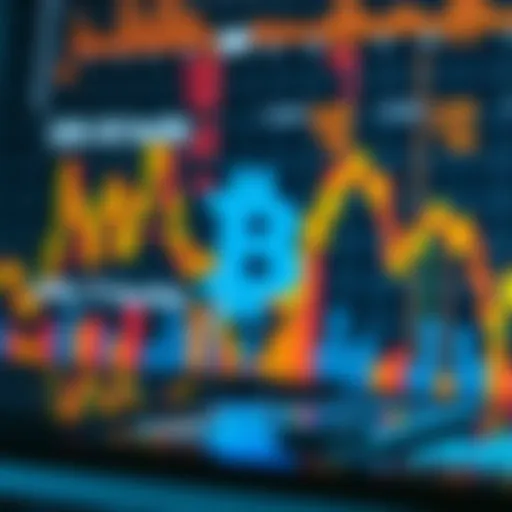Exploring the Curve Token: A Complete Overview


Intro
In the sprawling universe of decentralized finance, the Curve Token emerges as a significant entity. As various digital assets form the bedrock of this new financial landscape, understanding Curve Token’s role can illuminate the broader workings of decentralized finance platforms. This comprehensive guide aims to dissect every facet of the Curve Token, providing clarity on its function within Curve Finance, its economic implications, and its dynamic impact on liquidity and yield.
Engaging with this topic requires an understanding that transcends just surface-level perceptions of cryptocurrencies; it demands a grasp of the functionalities and governance structures that underpin them. With its emphasis on optimized trading and efficient liquidity, Curve Finance has made leaps and bounds in reshaping how investors and users alike approach yield generation and liquidity provisioning.
Investors, analysts, developers, and enthusiasts alike will find this guide not only insightful but also essential in navigating the complexities of Curve Token and its ecosystem. As we dive deeper, we will uncover essential concepts, strategies, and ideas that can shape investment narratives.
Crypto Concepts Explained
To lay the groundwork, clarity on fundamental terms and ideas is essential. The following sections aim to unpack key terminology and explore practical applications of blockchain technology within the Curve ecosystem.
Key Terminology and Definitions
- Curve Finance: A decentralized exchange optimized for stablecoin trading, which facilitates low slippage trades and efficient liquidity provisioning.
- Liquidity Provider (LP): Individuals or entities that supply funds to a liquidity pool, earning fees in return.
- Yield Farming: A strategy where users lock up their cryptocurrencies in a platform to earn rewards like tokens, interest, or fees.
- Governance Token: A token that provides holders with voting rights in the platform's decision-making processes.
Grasping these terms is vital as everyone wants to move from the theoretical to the practical, immersing themselves in the Curve Token environment.
Practical Applications of Blockchain Technology
The advantages of blockchain technology are vast, and within the context of Curve Finance, a few standout applications include:
- Decentralization: Eliminating the middleman increases trust and transparency, allowing users to interact directly.
- Smart Contracts: Automatic execution of terms without the need for intermediaries, streamlining various processes.
- User Empowerment: Giving users control over funds and strategies, aligning interests directly with performance.
As blockchain technology develops, it continually alters the landscape, making concepts like yield farming a reality rather than a distant dream. This shift represents a pivotal moment for many investors and developers in relation to both access and opportunity.
Investment Strategies
With a foundational understanding in place, transitioning to investment strategies is the next logical step. Evaluating market trends and managing risks will help users attain their financial goals effectively.
Analyzing Market Trends and Indicators
- Market Sentiment: Understanding whether the market is bullish or bearish can influence investment decisions in Curve Token.
- Liquidity Metrics: High liquidity might indicate healthier trading conditions, whereas lower liquidity could represent a risk for investors.
- Yield Metrics: Knowing how much liquidity pools pay out can inform decisions. Consider utilizing tools like DeFi Pulse or Zapper for monitoring.
Keep a keen eye on these indicators, as they can directly impact profitability and overall exposure in decentralized finance.
Risk Management Techniques
Every investment inherently carries risk – thus, employing effective risk management techniques is crucial:
- Diversification: Don't put all your eggs in one basket; spread investments across different pools or cryptocurrencies to mitigate risks.
- Setting Stop-Loss Orders: Create safety nets that limit potential losses if an investment's value drops unexpectedly.
- Regular Portfolio Reviews: Frequently assess your investment performance and reallocate as needed based on market conditions.
With careful attention to these strategies, investors can make calculated decisions in a highly dynamic environment. The pathway to success in Curve Token is not merely about understanding the technology but blending knowledge with astute investment planning.
Preamble to Curve Token
In the broad expanse of decentralized finance, Curve Token emerges as a significant player, not just because of its innovative approach but also due to the pivotal role it plays within Curve Finance. Understanding Curve Token is essential for anyone looking to harness the potential of DeFi. This section unpacks its relevance and the various facets that set it apart, offering a clear lens through which investors and enthusiasts alike can gauge its importance.
Understanding DeFi and Curve Finance
Decentralized Finance, often dubbed DeFi, represents a seismic shift in the financial landscape. It leverages the power of blockchain technology to provide open, permissionless financial services to anyone with an internet connection. Within this ecosystem, Curve Finance stands out by focusing on optimized trading of stablecoins. This specialization enables users to swap tokens with minimal slippage, a critical benefit for those managing significant economic activities. Curve Finance employs automated market maker (AMM) models, creating liquidity pools that facilitate seamless transactions. Herein lies the essence of Curve Token; it is not merely a byproduct but the lifeblood that fuels this platform's functionalities.
As the growth of DeFi continues to accelerate, Curve Token's role becomes even more crucial. Investors find value in its capabilities as a medium for yield generation and liquidity provision. Moreover, understanding the mechanics of Curve's operation can empower users to navigate the space more effectively, increasing their engagement with DeFi. Curve’s design caters indirectly to a broader audience, including developers who can tap into its infrastructure while ensuring that it remains user-friendly for everyday individuals.
The Evolution of Curve Token
The story of Curve Token is still being written. Launched in 2020, it was conceived through the collaborative efforts of its founder, Michael Egorov, and a community of developers committed to revolutionizing the trading of stablecoins. In a market dominated by volatility, Curve aimed to minimize price fluctuations during trades, laying the groundwork for its ecosystem.
Over the years, the token has undergone notable transformations. Initially grappling with the common challenges faced by new protocols, Curve never shied away from innovation. The introduction of various liquidity pools optimized for stablecoins facilitated more efficient trades and attracted a diverse user base.
The evolution didn't stop there. With each iteration, Curve Token has expanded its reach, integrating into cross-platform applications and continuously improving user experience. Collaborations with projects like Yearn Finance have further solidified its standing within the DeFi sphere, showcasing its adaptability and determination to cater to market needs.
Understanding this evolution offers valuable insight into why Curve Token is more than a mere cryptocurrency; it represents a proactive response to the demands of modern finance. As we delve deeper into its mechanics and implications, the relevance of Curve Token within the DeFi ecosystem becomes ever more apparent.
Mechanics of Curve Token


The mechanisms behind Curve Token are the beating heart of its functionality within the broader decentralized finance landscape. Understanding these mechanics is not just an academic exercise; it’s essential for anyone looking to engage meaningfully with this innovative financial protocol. Curve Token supports a decentralized exchange (DEX) model, allowing for seamless stablecoin swaps and liquidity provision, both critical in achieving efficient market operations.
How Curve Works
Automated Market Maker Concept
At its core, Curve operates on the automated market maker (AMM) model. Unlike traditional exchanges that match buyers to sellers, AMMs facilitate trades through liquidity pools. This model is noteworthy for several reasons. Firstly, it allows users to trade cryptocurrencies quickly and without the need for a central authority, which often slows down the process. The key characteristic of the AMM model is its ability to set prices using a predetermined algorithm, maintaining liquidity even with relatively low volumes.
One particular aspect to highlight is the constant product formula utilized in many AMMs, including Curve. This unique feature helps maintain a balance between the tokens in the pool, ensuring that liquidity is available for traders. However, it’s not without its challenges. Traders may face slippage during high volatility periods, making it crucial for investors to understand when engaging with these pools.
Despite its complexities, the AMM concept remains a popular choice due to its transparent nature and reduced reliance on intermediaries. The ability to access liquidity instantly without cumbersome procedures underscores why AMMs are becoming essential instruments within DeFi.
Stablecoin Swaps
Stablecoin swaps represent yet another critical mechanism in Curve's operation. The fundamental concept here is simple: it allows users to exchange one stablecoin for another with minimal friction and cost. This is particularly valuable in the ever-evolving crypto markets, where price stability is paramount for users trying to minimize risk amidst the chaos.
A defining feature of stablecoin swaps within Curve is their high efficiency. Unlike traditional exchanges where you might incur significant fees during swaps, Curve's low slippage and competitive transaction fees make it a go-to option for many users. However, one drawback to consider is the reliance on stablecoins which, despite their name, can still experience occasional peg disruptions.
Engaging in stablecoin swaps is beneficial not only for individual users but also for the overall liquidity of the platform. These efficient swaps result in increased trading volumes, enhancing Curve's attractiveness as a trading platform, which can lead to increased participation from liquidity providers as well.
The Role of Liquidity Providers
Liquidity Pools Explained
Liquidity pools are crucial in enabling the Curve platform to function effectively. When users supply their assets into these pools, they are effectively providing the liquidity needed for swaps and trades. The underlying principle is straightforward: users deposit stablecoins into a pool, and in return, they earn transaction fees proportional to their contribution.
The key characteristic of these pools is their incentivization of participation. Liquidity providers earn passive income simply by sharing their assets, which many find appealing. This aspect is particularly compelling given the alternative of letting assets stagnate while market opportunities come and go.
Despite their advantages, liquidity pools come with risks. For instance, during severe market fluctuations, liquidity providers may experience impermanent loss, where the value of their contributions could be lower than if they had held onto their assets instead. Thus, it’s imperative for potential providers to weigh the benefits against the risks carefully.
Rewards for Participants
Rewards for liquidity providers are an essential component of Curve’s ecosystem. Not only do they earn fees from trades, but they often receive additional incentives in the form of Curve Tokens or governance tokens from participate in liquidity mining programs. This model not only enhances user engagement but also promotes the ongoing health of the Curve ecosystem.
A focal point of the rewards system lies in its flexibility. Providers can choose different pools according to their risk tolerance and desired returns. For those who prefer a more hands-off approach, simply depositing assets into a stablecoin pool may suffice. Meanwhile, others may look towards riskier pools for potentially higher rewards.
However, as appealing as rewards may sound, it’s also essential to consider the fluctuations in the returns based on pool activity and market conditions. Keeping a close eye on available data is recommended to ensure that participants are not leaving money on the table and that risks are well managed.
Overall, the mechanics of Curve Token intricately weave together multiple components that not only create a functioning market but also establish an ecosystem ripe with opportunities for both users and investors. With the pivotal role of liquidity providers and the uniqueness of the AMM model, understanding these mechanics puts one in a better position to navigate the broader complexities of Curve Finance.
Economic Implications of Curve Token
Understanding the economic implications of Curve Token extends beyond mere numbers; it dives into how this digital asset interacts with the broader financial ecosystem. As decentralized finance (DeFi) continues to establish its foothold, the role of Curve Token takes center stage. Through its intricate tokenomics and strategic market positioning, Curve Token presents both opportunities and challenges for investors, developers, and enthusiasts alike.
Tokenomics Overview
Supply Dynamics
Supply dynamics refer to the aspects of how Curve Token is produced, managed, and ultimately influences its value within the market. This characteristic is vital, as it shapes investor perception and market fluctuation. One key element of supply dynamics is that Curve Token has a capped supply, which adds a layer of scarcity to its valuation. This scarcity is generally considered a desirable quality in the world of cryptocurrencies. In the context of Curve, it serves to protect against inflation, as the total number of tokens will not blindly inflate over time.
The unique feature of this supply mechanism is its predictable release schedule of new tokens, allowing investors to foresee changes in the supply side of the market. It generates foundational credibility, encouraging participation in liquidity pools and yield farming initiatives. However, potential disadvantages include speculative pressure from early investors looking to cash out quickly, which could lead to price volatility.
Distribution Mechanisms
The distribution mechanisms of Curve Token are equally crucial in determining its economic standing. Curve adopts a dual-token model, comprising Curve DAO Tokens (CRV) and reward structures for liquidity providers. This dual approach enhances accessibility for users and allows a broader audience to engage with the platform.
Key to this mechanism is community engagement. The distribution isn't just about rewarding early adopters; it also facilitates long-term loyalty among users, as tokens generated from liquidity provision can be staked for additional rewards. This promotes a sustainable ecosystem that encourages users to stay invested in Curve Finance’s success. Nonetheless, critics might argue that the complexity of these mechanisms may deter new users unfamiliar with such advanced concepts, limiting overall adoption.
Market Positioning
Comparison with Competitors
When examining Curve Token's market positioning, a crucial factor is how it measures up against competitors like Uniswap and Sushiswap. Curve's commitment to offering efficient stablecoin swapping gives it a niche position. Its liquidity pools are tailored for stablecoin pairs, which offers unique advantages in terms of less volatility while still providing meaningful returns for liquidity providers.
The unique feature of this approach is that it enables users to engage in stablecoin exchanges at a lower price, improving overall trading efficiency. However, the trade-off is that it may not attract users seeking to trade volatile assets, thus potentially limiting its market reach. Despite this, its specialized focus has earned it significant interest among those primarily trading stablecoins, contributing positively to its market identity.
Market Trends and Analysis


Looking at the broader market trends, the performance of Curve Token remains closely tied to the overall adoption of decentralized finance products. The growth of liquidity provision, decentralized exchanges, and the continual innovation in DeFi protocols all play into how Curve Token is perceived within this landscape. The importance of adapting to new trends cannot be overstated; Curve continually refines its platform, integrating aspects such as governance and community input, further solidifying its relevance.
One unique component of this trend is the rise of decentralized autonomous organizations (DAOs) within DeFi, which has shifted how projects are managed and developed. Curve's responsiveness to these trends strengthens its positioning, allowing it to be viewed as a relevant player in a swiftly changing market. Potential downsides could include the risk of becoming too reactive to trends rather than leading them, a delicate balance to maintain in such a dynamic environment.
"Economic implications of Curve Token extend beyond just immediate profits. They shape the entire investor experience and affect how communities engage with the project."
By analyzing these economic implications, stakeholders can better appreciate Curve Token's pivotal nature in the ecosystem. This depth of understanding is essential for navigating the excited yet often treacherous waters of cryptocurrency investments.
Governance Structure of Curve Token
The governance structure of Curve Token plays a significant role in shaping its ecosystem and functionality within the decentralized finance landscape. A well-established governance framework ensures that the voices of stakeholders are heard, fostering a community-driven approach to innovation and problem-solving. It’s not just about who’s calling the shots; it’s about creating an environment where every participant feels invested in the project’s future. This section delves into the critical components of this governance model, detailing its mechanisms and how they contribute to the overall health of Curve’s operations.
Decentralized Governance Model
Voting Mechanisms
In the context of Curve Token, voting mechanisms serve as the backbone of its decentralized governance. At its core, this mechanism empowers token holders to participate actively in decision-making processes, influencing various aspects of the protocol, from key upgrades to operational policies.
One of the standout characteristics of Curve's voting system is its use of governance tokens, which link decision-making power directly to token ownership. This setup incentivizes participants to engage meaningfully, as their stakes in the protocol have a direct connection to governance outcomes. As a beneficial choice for Curve’s ongoing development, the model encourages a sense of ownership among investors, analysts, and developers alike.
However, it’s not without its pitfalls. One unique feature of Curve's voting mechanisms is the delegation of votes. Token holders can delegate their voting power to others, which opens avenues for more informed decision-making. Yet, it also introduces complexities, as voters must navigate trust and reliability among potential delegates. Balancing these advantages against the risk of misalignment can be tricky and demands careful consideration.
Community Participation
Community participation is another critical pillar of the decentralized governance model. It's important because it taps into the collective intelligence of users and stakeholders, enriching the decision-making process with diverse perspectives.
A key characteristic of community participation in Curve is the ability for users—not just prominent stakeholders—to submit proposals for changes. This democratizes the governance process, enabling everyday users to advocate for modifications or enhancements they deem necessary. For the Curve Token, this participatory approach fosters inclusivity, ensuring that the governance model resonates well with a broader audience beyond just major investors or early adopters.
Moreover, this openness can be remarkably beneficial. It provides a real sense of community ownership, where every user has a stake in the protocol's direction and development. However, it can also pose challenges, such as potential information overload and decision paralysis when many voices are competing for attention. Ensuring that community participation leads to effective decision-making remains a critical concern.
Impact of Governance on Development
The impact of governance on the development of Curve Token cannot be overstated. A robust governance framework enables seamless updates and adaptations to evolving market conditions, ensuring that Curve stays relevant and competitive. Actions taken through the governance structure can catalyze improvements in protocol efficiency, user experience, and overall market positioning.
What truly stands out in Curve's governance model is its capacity to adapt and respond to community feedback and insights. This iterative approach to development allows for a dynamic evolution of the project, driven by the very users who interact with it every day.
Challenges and Critiques
The journey through the world of Curve Token isn’t all smooth sailing; it has its fair share of bumps along the road. Understanding the challenges and critiques surrounding Curve Token is crucial for those involved in this exciting but unpredictable landscape. This section focuses on specific risks and regulatory implications that could make or break investors’ experiences.
Potential Risks of Curve Token
Market Volatility
Market volatility can be aptly described as the life of the high-stakes party that is cryptocurrency. It's that well-known aspect where prices can swing like a pendulum, creating both frenzy and fear. In the case of Curve Token, its volatility stems from various factors, including market demand, liquidity levels, and the broader DeFi ecosystem’s temperament.
One key characteristic of this volatility is its potential to amplify gains as well as losses. For investors, especially newcomers, this can feel like walking a tightrope. A sudden price drop can turn a good day into a bad one in a matter of minutes. However, some seasoned investors see this as a chance to prove their mettle, diving in when others are fluttering in fear.
A unique feature of market volatility tied to Curve is the role of liquidity pools. These pools can determine how smoothly trades are executed.
- Advantages: The opportunity to capitalize on price swings can lead to significant profits.
- Disadvantages: In a rapidly shifting market, it’s also easy to lose value quickly, leading to potential capital erosion.
Smart Contract Vulnerabilities
Smart contracts hold the promise of automating processes without a hitch but they’re not foolproof. These lines of code can be the Achilles' heel when not properly audited. Curve Token utilizes smart contracts for many functionalities, which underscores their critical importance in ensuring a smooth operation.
What makes this characteristic shine is the potential for human error or oversight during the coding phase. For instance, a minor bug can result in significant financial losses for investors. A well-known example in the crypto world is the infamous DAO hack, which revealed just how easily insecure smart contracts could be manipulated.
Some unique aspects of smart contract vulnerabilities include:
- Blockchain Transparency: While blockchain technology allows for transparency, it also means that vulnerabilities may be visible to malicious parties.
- Advantages: If these contracts are audited thoroughly, they can create exceptionally secure environments for transactions.
- Disadvantages: Failure to address vulnerabilities can lead to serious financial turmoil not just for individuals but whole communities.
Regulatory Considerations
Compliance Issues
In the realm of cryptocurrency, compliance issues are like the weather – you can’t ignore them, and they can change rapidly. Compliance is critical as regulatory bodies strive to adapt to the fast-paced developments in the DeFi sector. For Curve Token, navigating these regulations is pivotal for its reputation and longevity in the market.


The key characteristic of compliance issues is the ever-evolving nature of regulations. Governments are working round the clock trying to catch up with innovations. Curve Token must carefully consider its operations to avoid running afoul of these requirements.
Unique features of compliance issues include:
- Regulatory Scrutiny: Increased governance can bolster trust among investors.
- Advantages: A clear compliance strategy can attract institutional interest.
- Disadvantages: However, stringent regulations might stifle innovation and make processes cumbersome.
Future Regulatory Landscape
Looking ahead, the regulatory landscape for Curve Token is likely to change in ways that could significantly impact its operation. Understanding the potential shifts that may come can help investors make informed choices moving forward.
One defining characteristic of the future regulatory landscape is its unpredictability. As governments and organizations globally begin to recognize the prominence of cryptocurrencies, regulations will likely get tighter.
Some unique aspects of this evolving landscape include:
- Global Harmonization: Future regulations might aim for a more standardized approach across borders, enabling smoother operations for entities like Curve.
- Advantages: This could facilitate larger institutional investments in DeFi, increasing overall market stability.
- Disadvantages: On the flip side, too much regulation may dampen the innovative spirit of DeFi projects or drive them to less regulated environments.
"Understanding these challenges and critiques regarding Curve Token isn't just recommended, it's essential for anyone looking to dip their toes in the DeFi waters."
This section has shed light on the various risks and regulatory nuances tied to the Curve Token. As much as they present opportunities, they also harbor risks that savvy investors should remain vigilant about.
The Future of Curve Token
Looking ahead, the discussion about the future of Curve Token is both exciting and crucial. As decentralized finance continues to evolve, understanding where Curve Token fits in this landscape is more than just an academic exercise; it’s about recognizing opportunities and challenges that lie ahead. The combination of technology, community engagement, and market dynamics will shape Curve's role in the larger DeFi ecosystem.
The growth of DeFi means that Curve Token might expand its applications. There are reasons to believe that its innovative mechanisms could be adapted to new scenarios, creating fresh avenues for both liquidity providers and investors. Understanding these potential developments is essential for anyone looking to navigate the complexities of cryptocurrency investments.
Predicted Trends in DeFi
Integration with Other Platforms
One critical aspect of Curve Token’s future is its integration with other platforms. As more users venture into the DeFi realm, seamless interoperability becomes a necessity. This might mean partnerships with other trading platforms, lending protocols, or even traditional financial institutions. Such integrations can facilitate easier access to Curve’s unique liquidity mechanisms, making it a more attractive option for new users.
An important characteristic here is the ability to build synergies. By integrating with popular DeFi platforms like Aave or Yearn Finance, Curve can enhance its reach. These partnerships not only boost the visibility of Curve Token but also create mutual benefits, such as increased liquidity and user engagement.
However, integrations bring their own challenges. More connections can mean more vulnerabilities. The risk of dependence on external systems and protocols can sometimes outweigh the potential benefits. Thus, careful consideration and strategic partnerships will be vital for Curve’s future success.
Emerging Use Cases
Another intriguing aspect is the development of emerging use cases for Curve Token. Beyond mere liquidity provision, Curve could be used creatively within various financial products. For instance, the protocol could enable newer forms of lending, staking, or yield aggregation that leverage stablecoin volatility in more dynamic ways. The ability of Curve to adapt to shifting user demands is a key highlight of its potential.
What makes emerging use cases so compelling is their emphasis on user-centric design. By listening to the community and understanding what users truly desire from DeFi, Curve could find ways to innovate that align with market needs. Yet, there are considerations to keep in mind; diving into new functionalities may carry the risk of overcomplicating the user experience, which should always remain intuitive and straightforward.
Long-Term Viability of Curve Token
Finally, discussing the long-term viability of Curve Token ties in directly with both its governance and its technological adaptability. The capacity to evolve with market trends while maintaining a solid governance framework is crucial. An engaged and informed community can ensure that Curve remains responsive to changes.
As the DeFi sector can be a fickle friend, understanding market cycles, along with Curve’s adaptability, will play a pivotal role in its sustainability. Investors, developers, and enthusiasts must keep a close watch on how Curve navigates this landscape, knowing that while there are risks, there are also significant rewards on the horizon.
As the landscape of decentralized finance shifts, the future of Curve Token can hold unprecedented possibilities—with active participation from its community guiding the way.
End
The conclusion of this article serves as an essential wrap-up, drawing together various threads we've explored around Curve Token. It's a moment to pause and consider not just what we’ve discussed, but why it matters in the grand scheme of decentralized finance (DeFi). Understanding Curve Token isn’t merely an academic pursuit; it holds tangible implications for investors, developers, and enthusiasts alike.
Key Takeaways
Here are some vital points reinforced throughout the article:
- Understanding Mechanics: Curve Token operates on a unique Automated Market Maker model, enabling efficient stablecoin swaps and enhanced liquidity.
- Tokenomics Insight: Grasping the supply dynamics and distribution mechanisms sheds light on its market behavior and potential for growth.
- Governance Matters: The decentralized governance structure empowers community participation, emphasizing the significance of collective decision-making in the token's evolution.
- Future Watch: Recognizing predicted trends in DeFi can inform investments and strategic moves within the crypto landscape. The integration of Curve Token with other platforms paves the way for emerging use cases that might redefine its role in finance.
Understanding these elements helps stakeholders make informed decisions that could affect their investments in the increasingly volatile and complex cryptocurrency space.
Navigating the Curve Token Ecosystem
Navigating the Curve Token ecosystem can appear daunting at first glance, but with the right insights, it becomes much more understandable. First, it’s crucial to familiarize oneself with key resources. Various online communities and forums, such as Reddit and dedicated Discord groups, provide ongoing discussions about trends and changes. Moreover, checking out Curve Finance's official documentation can help clarify specifics about the platform and token's functionality.
Next, one should consider the importance of liquidity providers. Engaging actively as a liquidity provider not only supports the ecosystem but also offers personal benefits such as earning transaction fees. Understanding the risks involved, such as impermanent loss, is equally important—it can influence decision-making.
Lastly, staying updated on regulatory shifts is key. Regulatory decisions can ripple through the market, altering dynamics overnight. Therefore, being aware of current regulatory landscapes and compliance issues keeps investors and developers one step ahead.
"In DeFi, knowledge is your best ally; understanding the ecosystem's intricacies can transform challenges into opportunities."
With these insights and resources, stakeholders can venture confidently into the Curve Token network, equipped to navigate the complexities of this evolving space.















